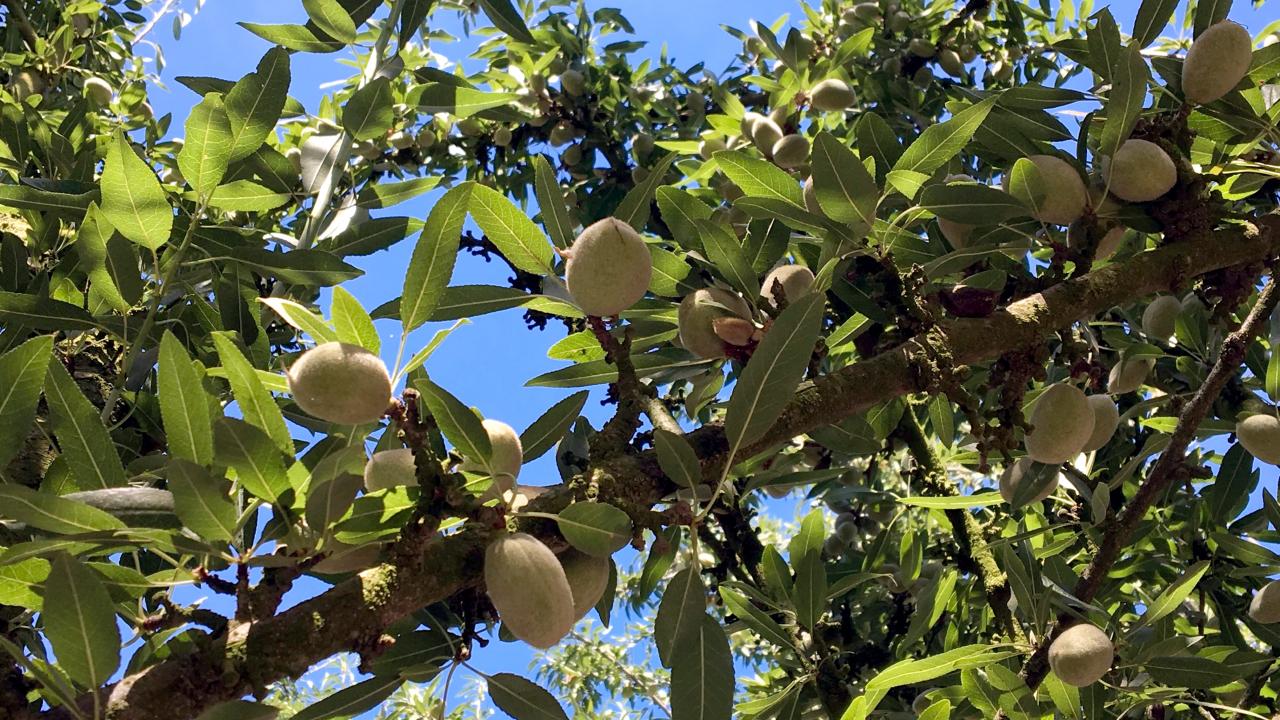
Nitrogen Efficiency
Coming together to protect the planet and feed the world
Art Bowman has been growing almonds in Modesto for more than 40 years. He stays up-to-date on the latest science and invests in technology that keeps his farming sustainable. He uses precision technology to apply nitrogen, for example, that essentially spoon-feeds water and nutrients to his trees.
“Our yields have increased quite a bit since we switched to precision application,” says Bowman, adjusting his hat against the noonday sun. “And that’s without adding any extra nitrogen. That’s huge.”
Besides almonds, Bowman has something else developing in this fertile field—nitrogen efficiency research. A team of UC Davis experts has installed one tower, 20 wells and many yards of tubes on Bowman’s farm to measure the complete nitrogen cycle—what goes in and what goes out. The uniquely interactive project will shed light on perhaps the most pressing question in agriculture today: How do we nourish the crops that feed us without harming the environment in which we live?
“It’s about balance,” says UC Davis plant physiology professor Patrick Brown, standing beside Bowman beneath a tree. “When we work together to understand the science and the constraints, we can design a system that maximizes nitrogen efficiency and minimizes impact on the environment.”
Why Nitrogen Matters
All plants need nitrogen to grow. Nitrogen is vital to producing high-yield crops to feed billions of people worldwide. But excess nutrients can pollute air and drinking water and cause serious health and environmental risks.
Every crop has different nutrient needs, and even those requirements vary based on factors such as soil type, weather, irrigation and how much nitrogen crops can access from organic matter in the soil. Crops suffer if they don’t get enough nitrogen, but too much is bad, too. Excess nutrients can leach into groundwater, which many Californians depend on for drinking water.
It’s hard to track the timing and source of pollutants in groundwater. Pollutants can leach down from farms and dairies, and also from industrial uses, such as gas stations. It can take years and even decades to detect nitrogen in a drinking-water well, so it can be difficult to evaluate groundwater impacts from current farming practices.

A Changing Landscape
Nitrogen use has changed dramatically in California. Forty years ago, farmers generally applied a year’s worth of fertilizer at the start of the season.
“We’d broadcast it out and hope for the rains to come,” Bowman remembers.
The rains did come, and too often washed away excess nutrients or leached them below the root zone. As Brown says, “It’s like feeding your pigs all their food all at once and expecting any to still be there at the end of the year.”
These days, most farmers apply smaller amounts of nitrogen throughout the season. UC Davis researchers have created online resources such as the California Fertilization Guidelines to help farmers determine the rate and timing of application to meet their plants’ needs.
Studying the Whole Puzzle
Researchers have a good understanding of how much a crop needs and when it needs it. This five-year project will shed light on the bigger picture.
“We’re looking at all the puzzle pieces, all at once,” Brown says. “We’re studying the entire nitrogen cycle above ground, at the root level and down deeper in the groundwater. We’re measuring nitrogen emissions, and we’re also surveying 6,500 farmers to better understand their needs and constraints. While a sound knowledge of the science of nitrogen is critical to future sustainability, it is equally important we understand how growers are implementing these advances and the challenges they face.”
The UC Davis team includes faculty, postdoctoral and graduate student researchers in hydrology, plant physiology, environmental policy and other fields. Researchers are collaborating with the California Almond Board, government agencies, regional water boards, farmers, environmentalists and others.
“We find solutions when we work together,” Brown says.
Policymakers are designing laws to regulate how farmers manage nitrogen. This project seeks to build consensus and provide scientific basis for those regulations.
The Perfect Plot
This experiment couldn’t happen without farmers like Bowman, according to Thomas Harter, Cooperative Extension specialist with the UC Davis Department of Land, Air and Water Resources. Harter is leading the study’s groundwater component.
“We needed 150 acres in San Joaquin Valley with a specific soil profile, a fairly shallow water table and no interferences from other sources of nitrogen, like dairies,” Harter says. “It’s not easy to find someone willing to open up their orchard and accommodate our equipment and researchers, let alone work together to improve management practices. Art is a tremendous collaborator.”
Bowman is happy to help researchers get good data for such a critical cause.
“Nitrogen efficiency matters to us all,” Bowman says. “I will pass this land on to my children—I care about the environment. I support farming practices that are good for the environment, and that are manageable and economically sustainable, too.”